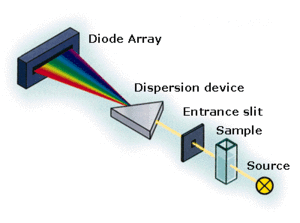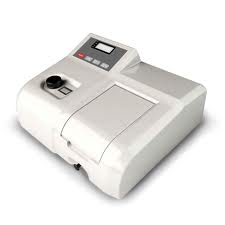Spectrophotometers
Spectrophotometer measures either the amount of light reflected from a sample object or the amount of light that is absorbed by the sample object.Spectrophotometry is the quantitative study of electromagnetic spectra.
Design
In short, the sequence of events in a modern spectrophotometer is as follows:
- The light source shines on the sample.A fraction of the light is transmitted or reflected from the sample
- The light from the sample is directed to the entrance slit of the monochromator
- The monochromator separates the wavelengths of light and focuses each of them onto the photodetector sequentially.
There are two kinds of spectrophotometers: single beam and double beam. A double beam spectrophotometer compares the light intensity between two light paths. One path containing a reference sample. The other the test sample. A single beam spectrophotometer measures the relative light intensity of the beam before and after a test sample is inserted. A double beam machine makes comparison readings easier and more stable. But a single beam machine can have measure a wider range of light frequencies. Single beam machines have simple optical systems and are more compact. When the spectrophotometer is built into another device only single beam machines will work.
These machines depend on the beam of light being limited to just one frequency or wave length. Spectrophotometers can use wave lengths from 200 nm - 2500 nm. Historically, spectrophotometers use a monochromator containing a diffraction grating to produce the analytical spectrum. The grating can either be movable or fixed. The measurement is made at the other end of the beam by Detectors. If the machine has a single detector, the grating can be scanned stepwise so that the detector can measure the light intensity at each wavelength . In an alternative design, a row of detectors are used. These may be charge coupled devices (CCD) or photodiode arrays (PDA). In such systems, the monochromator grating is fixed and the intensity of each wavelength of light is measured by a different detector in the array. Additionally, most modern mid-infrared spectrophotometers use a Fourier transform technique to acquire the spectral information. The technique is called Fourier Transform Infrared.
In both single beam and double beam machines, the light being measured is either passed through the sample or bounced off the sample . When making transmission measurements, the spectrophotometer quantitatively compares the fraction of light that passes through a reference solution and a test solution. For reflectance measurements, the spectrophotometer quantitatively compares the fraction of light that reflects from the reference and test samples. Light from the source lamp is passed through a monochromator, which diffracts the light into a rainbow of wavelengths and outputs narrow bandwidths of this diffracted spectrum. Discrete frequencies are transmitted through the test sample. Then the photon flux density of the transmitted or reflected light is measured by the sensor.
The transmittance or reflectance value for each wavelength of the test sample is then compared with the transmission values from the reference sample.Many older spectrophotometers must be calibrated by a procedure known as zeroing. The absorbancy of a reference substance is set as a baseline value, so the absorbancies of all other substances are recorded relative to the initial zeroed substance. The spectrophotometer then displays % absorbancy . Spectrophotometers can also measure luminescence. For example, the machine can shine ultraviolet light of one frequency on the sample. This will excite the sample and make it glow. The detectors can the measuring the light glowing from the sample at a different frequency.

